V. Atlas and Catalog Generation
4. Duplicate Source Resolution
The footprint of each WISE Atlas Tile on the sky has a portion overlapped by neighboring Tiles. How the Atlas Tiles are positioned to cover the sky is described in IV.5.a.i.1 The amount of overlap varies with declination, converging towards the Equatorial poles with increasing overlap to a maximum overlap at the poles.
Sources that fall within the overlap regions may have been detected in each overlapping Tile. Therefore, the Wise Working Data Base (WDB) contains multiple measurements for many of these sources. Only one of the duplicate source detections will be selected as the 'best' detection to represent the source in the Catalog. The selection algorithm is based purely on geometric criteria - select the detection that is furthest from its closest Tile edge. This distance to edge algorithm is the same algorithm used by 2MASS. The selected detection becomes a candidate for the Catalog.
Duplicate Resolution Process
The following steps outline the Duplicate Resolution Process:
- Identify and group associated detections.
- Selection of best detection
- Eliminate most spurious detections from the group.
- Select a single detection from remaining detections in the group to represent the source.
a. Groups
The process of identifying groups of positionally associated detections was performed using the Working Auto-Correlation software (WAX). WAX was originally designed for 2MASS to operate on very large data sets allowing partitioning the sky into declination-ordered bands for enabling parallel operations. Although minor code adjustments were necessary to execute WAX on the WISE WDB, the core WAX algorithm remains the same. Detailed documentation for WAX is available.
WAX assigns every detection in the coverage area to a group, regardless of whether it is in an overlap region. Therefore, a group may have a single detection within the single Tile coverage region, or multiple detections within an overlap region where each detection is from a separate Tile. It is also possible for a group to have multiple detections within a non-overlap Tile coverage region. This occurs if there are multiple detections within the search radius from a single Tile.
The Duplicate Resolution Process works on all groups throughout coverage area.
b. Associating Groups of Detections Using WAX
Independent measurements of the positions of an inertial source
will be spread over a small error because of natural measurement errors.
The degree of spread is primarily a function
of source signal-to-noise ratio, but can also be increased by
systematic astrometric calibration errors, and confusion with
nearby sources and transients such as cosmic rays and hot pixel events
impinging on a source image. If the true position of a source
was known a priori, then finding all available detections of it
within a given WDB table would simply require searching a region around
that position that was large enough to cover the expected spread
in the individual sightings.
Of course, a priori positions are not known, so WAX employed
a detection density-directed search to identify spatially associated
groups of extractions.
WAX processing began by making a pass through a WDB table
to compute for each entry the centroid and
density of a provisional group of extractions that lie within
a specified angular distance from the initial entry, ri.
The density is defined as the number of other
extractions that fall within the search region, and the centroid is
the average position of all provisional group members.
For this step, relatively small (1") matching radii, ri,
were used.
This limit produced high reliability groupings at the expense of missing
some real group members.
Next, the WDB entries were sorted into decreasing density
order forming a queue of possible seeds. Final
groups were then constructed from the queue of seeds
as follows:
- Generate a group g from the seed s at the head of
the queue that contains all WDB extractions within a maximum separation,
rf, from the centroid of s.
- Extractions assigned to g are removed from the queue
of seeds, but are allowed to be associated with other
groups. Note that s at the head of the queue is always
removed from the seed queue.
- While the queue is not empty, repeat steps 1 and 2.
The density-ordered use of seeds is akin to peak finding
in source detection algorithms, but results in extremely poor WDB access
patterns (both to disk and in memory data). The algorithm therefore traverses
the input data multiple times in spatial order, generating groups around the
seeds encountered according to the following rules:
- A group
is generated around a seed centroid if and only
if the seed cannot be a member of any group generated
from a denser seed.
- When a group is generated around a seed s, then an
extraction
assigned to s is discarded from the set of seeds
if and only if it is less dense than s.
These rules result in identical output to the basic in-density-order
algorithm described above, regardless of the order in which seeds are
actually considered.
In some circumstances, the merging algorithm assigned an
extraction to more than one group. These extractions,
and the groups containing them, are said to be confused.
The grouping algorithm employed is conservative: if a detection can
be associated with more than one group, then it is allowed to do so,
and that detection and all of its containing groups are flagged as
confused. No attempt was made to resolve confused groups
to avoid introducing biases.
The group identification process lays down a set of sometimes
overlapping circular regions on the sky, and is thus
figuratively called the "swiss cheese" algorithm.
Figure 1 illustrates the "swiss cheese" algorithm, and shows how confusion
can arise. Panel (a) in the upper left shows the distribution of
source extractions in a small region of the sky that was
observed multiple times. Each one of
these extractions has an associated density and centroid
computed from the first pass of WAX processing. The first
group is identified in panel (b) having the highest density
of any of the extractions, and all of the extractions in that
group are removed from the list of seeds. The second
group is found among the remaining seeds in panel (c),
and its members are removed from the seed list. In panels
(d)-(f), groups are generated around the remaining
seeds that can incorporate extractions already assigned
to another group.
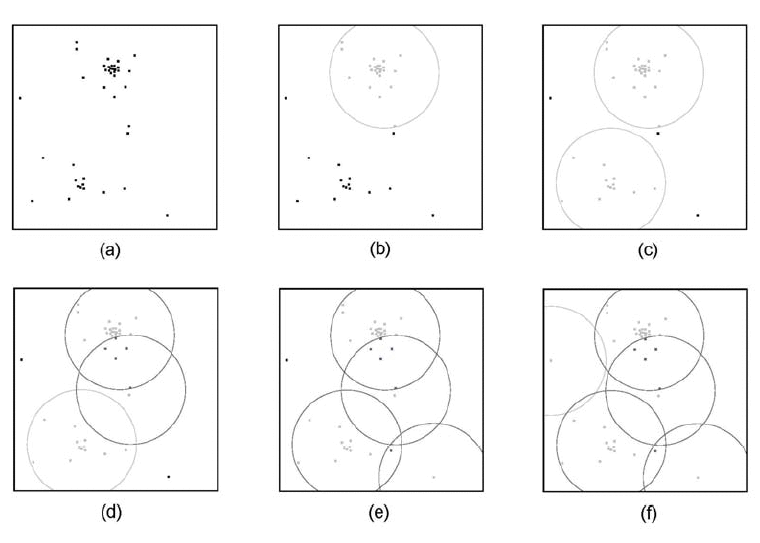 |
| Figure 1 - The "swiss cheese" algorithm for identifying
spatially associated groups of extractions in the WISE WDB
operating on a small region of the sky. (a) The raw extractions.
(b-c) The first and second groups are generated. Unprocessed
extractions are drawn in black, unconfused extractions and groups
in light grey. (d-f) As more groups are generated, confusion -
drawn in dark grey - appears.
(from Monkewitz and Wheelock 2005) |
i. Source Confusion
Source confusion occurs when a single Tile contributes more than a single detection to a group. This is different from the WAX defined group confusion described above. All groups whether in an overlap region or a non-overlap region containing more than a single detection will proceed through the Duplicate Resolution algorithm.
ii. Search Radius
The search radius used in WAX to generate the
final associated groups, rf, was 3".
It is large enough to recover virtually
all possible detections of sources, but not so large as to be badly
contaminated by detections of nearby sources, given the resolution of the WISE W1 Point Spread Function, described in IV.3.c.
Figure 2 shows the
number total WAX groups(top panel)
and WAX confused groups produced (bottom panel)
using a range of search radii, rf.
The point where the number of confused groups(bottom panel) crosses the number of total groups(top panel) found is about 3".
This provides the best balance between source detection completeness
and nearby source confusion.
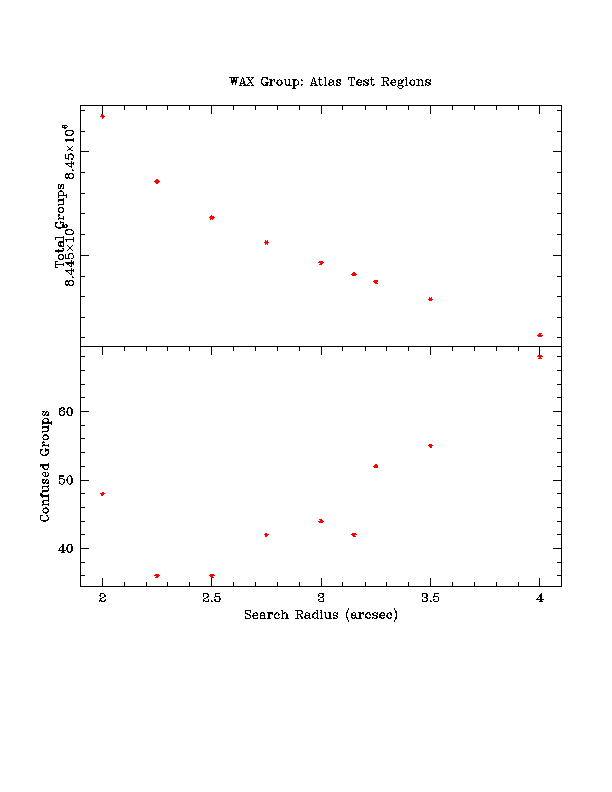 |
Figure 2 - Unconfused
merged groups (top) and
confused groups (bottom) as a function
of search radius, rf.
|
c. Detection Selection
i. Pre-Filter
Not all detections associated with a group are included in the selection process.
Some are flagged artifacts, some are too close to the Tile edge to obtain a reasonable aperture magnitude. A filter, which is applied prior to the distance to edge selection algorithm, eliminates most spurious sources.
Table 1 - Filter Criteria
| Filter Type | Magnitude | Artifact Flag | Distance to Edge | Reject/Accept |
| clean | detected1 in at least one band | lower-case artflag or 0 in all detected bands | | Accept |
| mixed | detected1 in multiple bands | lower-case artflag or 0 in at least one detected band
and uppercase artflag in at least one detected band | | Accept |
| spurious | detected1 in at least one band | upper-case artflag in all detected bands | | Reject |
| 4 band upperlimit | upper limits in all 4 bands | No upper-case artflag in any band | | Accept2 |
| 4 band upperlimit | upper limits in all 4 bands | upper-case artflag in at least one band | | Reject |
| distance to edge | any | any | minimum distance to edge < 50" | Reject |
Notes to Table 1
- 1 magnitude is NOT upper limit.
- 2 These detections are not in the Catalog due to the Catalog selection criteria, described in section V.3.
ii. Distance to Edge Selection
All groups that have more than a single detection, after filtering, go through the distance to edge algorithm. Since the image data contributing to the source detection in each Atlas Tile are the same, multiple detections of a source in the overlap region are considered redundant. A single detection is chosen from the redundant set to be a candidate for the Catalog. The selection is based on a distance to edge algorithm, choosing that detection which falls furthest from its closest Tile edge.
For each group of positionally-matched detections:
- For each detection in the matched group, the minimum of the east-west and north-south distances from the source to the nearest respective Tile edges is determined.
- The detection in the group that has the largest value of
min(dist_edge_ew, dist_edge_ns) is identified.
- The detection is rejected if the distance to edge for the selected detection is < 50". This results in no detection selected for the group and no detections from the group will be a candidate for the Catalog.
- Otherwise, the selected detection becomes a candidate for the Catalog, and all of the other detections in the group are rejected.
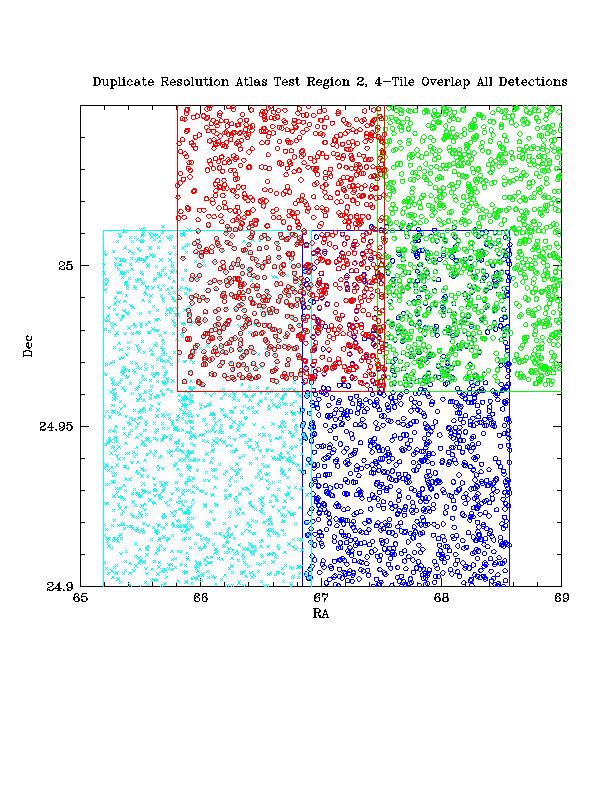 |
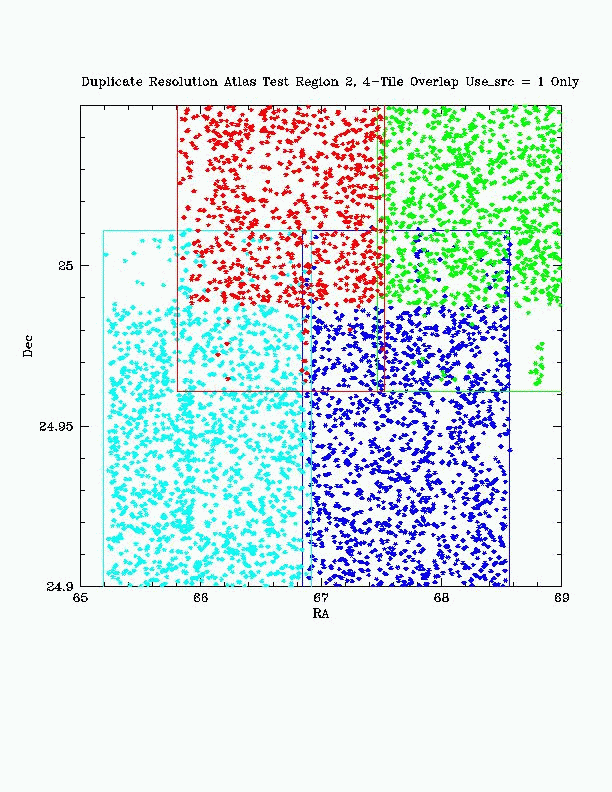 |
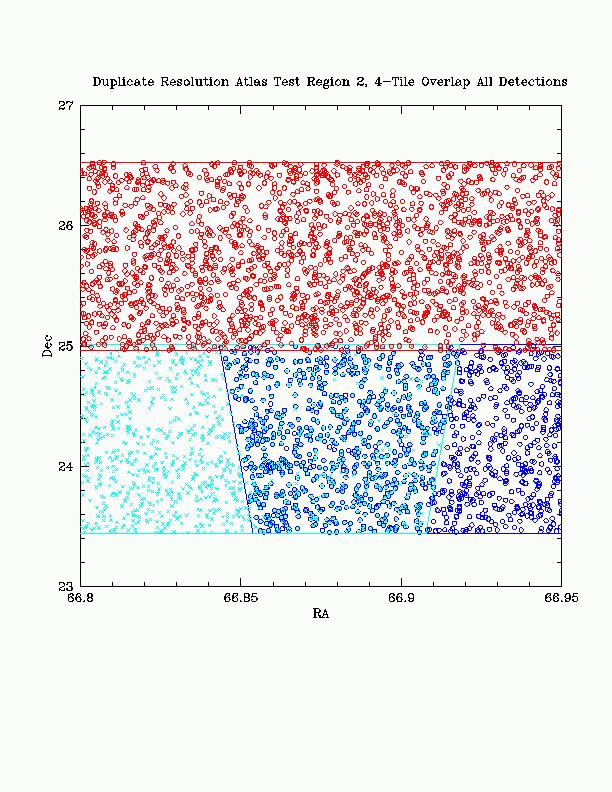 |
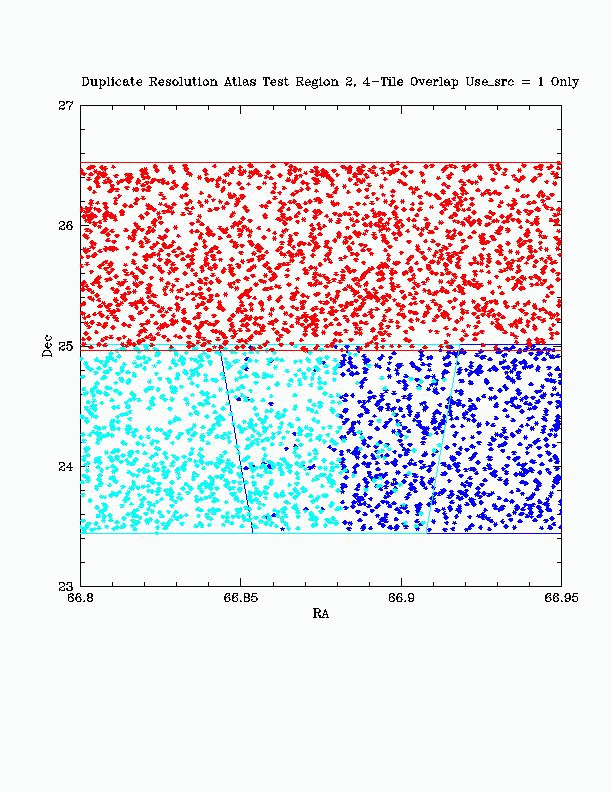 |
Figure 3a - Detail Declination View
Detections Only
Atlas Test Region 2: 4-Tile Overlap |
Figure 3b - Detail Declination View
Post Duplicate Resolution, all selected detections
Atlas Test Region 2: 4-Tile Overlap |
Figure 3c - Detail RA View
Detections Only
Atlas Test Region 2: 4-Tile Overlap |
Figure 3d - Detail RA View
Post Duplicate Resolution, all selected detections
Atlas Test Region 2: 4-Tile Overlap |
Figure 3 shows the results of the distance to edge algorithm using a 4-Tile overlap area from the Atlas Test DB. Detections prior to selection are seen in Figures 3a (for detailed Dec view) and 3c (for detailed RA view) using color to associate all detections from a single Tile. The selected detections are seen in Figures 3b and 3d.
Table 2 - Summary Counts Table
| Description | Count |
| total srcs in ATLAS WDB | 352839115 |
| total number of groups after WAX | 327369922 |
| total number of groups with valid selected detection | 310845961 |
| number of WAX-confused groups | 299 |
| number of source-confused groups in non-overlap regions | 29968 |
Table 2 provides summary counts of post duplicate resolution process for the WISE Atlas DB.
Last update: 2011 February 28
Previous page Next page
Return to Explanatory Supplement TOC





